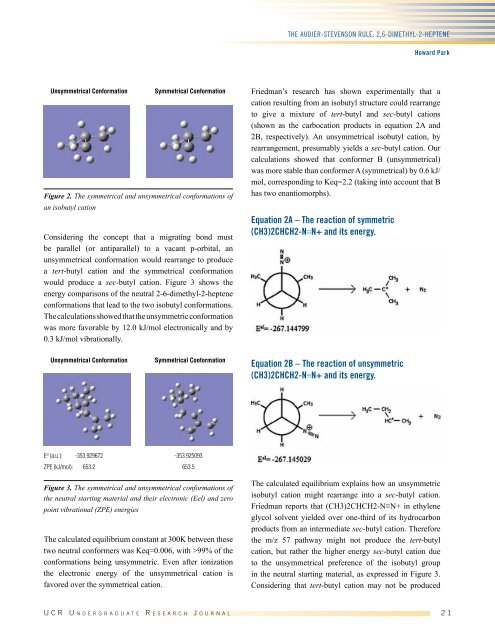Undergraduate Research Journal
Undergraduate Research Journal
Undergraduate Research Journal
Create successful ePaper yourself
Turn your PDF publications into a flip-book with our unique Google optimized e-Paper software.
The Audier-Stevenson Rule: 2,6-dimethyl-2-heptene<br />
Howard Park<br />
Unsymmetrical Conformation<br />
Symmetrical Conformation<br />
Figure 2. The symmetrical and unsymmetrical conformations of<br />
an isobutyl cation<br />
Considering the concept that a migrating bond must<br />
be parallel (or antiparallel) to a vacant p-orbital, an<br />
unsymmetrical conformation would rearrange to produce<br />
a tert-butyl cation and the symmetrical conformation<br />
would produce a sec-butyl cation. Figure 3 shows the<br />
energy comparisons of the neutral 2-6-dimethyl-2-heptene<br />
conformations that lead to the two isobutyl conformations.<br />
The calculations showed that the unsymmetric conformation<br />
was more favorable by 12.0 kJ/mol electronically and by<br />
0.3 kJ/mol vibrationally.<br />
Friedman’s research has shown experimentally that a<br />
cation resulting from an isobutyl structure could rearrange<br />
to give a mixture of tert-butyl and sec-butyl cations<br />
(shown as the carbocation products in equation 2A and<br />
2B, respectively). An unsymmetrical isobutyl cation, by<br />
rearrangement, presumably yields a sec-butyl cation. Our<br />
calculations showed that conformer B (unsymmetrical)<br />
was more stable than conformer A (symmetrical) by 0.6 kJ/<br />
mol, corresponding to Keq=2.2 (taking into account that B<br />
has two enantiomorphs).<br />
Equation 2A – The reaction of symmetric<br />
(CH3)2CHCH2-N≡N+ and its energy.<br />
Unsymmetrical Conformation<br />
Symmetrical Conformation<br />
Equation 2B – The reaction of unsymmetric<br />
(CH3)2CHCH2-N≡N+ and its energy.<br />
E el (a.u.): -353.929672 -353.925093<br />
ZPE (kJ/mol): 653.2 653.5<br />
Figure 3. The symmetrical and unsymmetrical conformations of<br />
the neutral starting material and their electronic (Eel) and zero<br />
point vibrational (ZPE) energies<br />
The calculated equilibrium constant at 300K between these<br />
two neutral conformers was Keq=0.006, with >99% of the<br />
conformations being unsymmetric. Even after ionization<br />
the electronic energy of the unsymmetrical cation is<br />
favored over the symmetrical cation.<br />
The calculated equilibrium explains how an unsymmetric<br />
isobutyl cation might rearrange into a sec-butyl cation.<br />
Friedman reports that (CH3)2CHCH2-N≡N+ in ethylene<br />
glycol solvent yielded over one-third of its hydrocarbon<br />
products from an intermediate sec-butyl cation. Therefore<br />
the m/z 57 pathway might not produce the tert-butyl<br />
cation, but rather the higher energy sec-butyl cation due<br />
to the unsymmetrical preference of the isobutyl group<br />
in the neutral starting material, as expressed in Figure 3.<br />
Considering that tert-butyl cation may not be produced<br />
U C R U n d e r g r a d u a t e R e s e a r c h J o u r n a l 2 1














